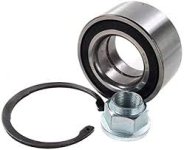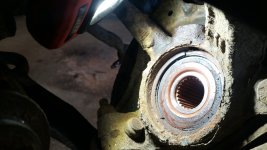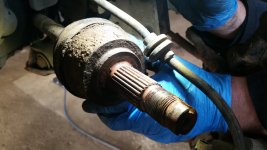Something like this just leaves me itching to plug in
MES and graph what the ecu thinks it's seeing from that sensor. However, in the absence of that - you want to check out the wiring before spending big money on the other items. You say a new sensor has been fitted - I hope the plug connections were carefully checked and I would include the connection to the ABS ECU at the other end - It's easy, just a plug to pull, visually inspect - including the wires where they enter the plugs as corrosion can establish where the wire is crimped to the back side of the connector if the seal gets damaged - possibly by back probing etc. If you can identify the wires, maybe from their colour codes? check for continuity from the ECU plug to your wheel sensor (wire colours should be identifiable at either end) Probably the most common thing is corrosion at the wheel end plug, but the wire may be broken inside the insulation where the wire transitions between suspension arm and chassis fixings due to flexing. ECUs do go wrong but not often so I always leave that as the last "suspect" in the train of investigation unless I get a fault code that specifically points to it.
On the bearing side of things this may help:
I know it's a Punto, but the Marea - I'd guess? - is going to be similar?
All looks oh so easy in this video but on older well rusted hubs, like yours, that big circlip which retains the bearing in place, can be an absolute sod to shift. A few years ago I did a front wheel bearing on my boy's car, because it was "noisy" which was a very similar setup to yours. Knowing that shifting the bearing would be difficult my local garage, where I'm well known and friends with, said if I stripped the hub out of the car and brought just the hub in on it's own - so it looked like the picture you've posted of your hub - they would remove the old bearing and fit the new one for me. In the event I was allowed to stay and watch and it was very interesting. The circlip had completely rusted into it's groove and took a couple of hours to chip out in wee pieces. The chap doing the job had a wonderful selection of chisels and "pointy" tools, many looked custom made, which he used to do this. But then we had the drama of pressing the bearing out of the hub. At first it just wouldn't move even though many tons of pressure were applied on their big floor standing hydraulic press. He then soaked the whole thing in more releasing oil and scraped away with more "pointy" tools around where the edge of the bearing was located in the bore of the hub. Then it was back onto the press again and with great pressure applied there was a sudden loud CRACK and the bearing started to move. After that it came out the rest of the way quite easily and, after a good clean up of the bore with some abrasive tape, the new bearing went in nice and smoothly. Started around 09.30 in the morning. I had a cup of tea with them for my lunch and left for home around 14.00 hrs. (I was chatting to "the boss" after the fitter had finished though and I do like to chat.) I couldn't believe it when they only charged me £40 all in - but they know they are my first stop for heavy stuff I can no longer manage, like clutches etc. By the way, I've never seen a drive flange driven out of a bearing simply with a hammer like he does. It's very usual for them to be so tight that the inner race of the bearing stays on the flange and then you've all the extra "fun" of pulling the race from the flange before you can reuse it!. (think angle grinder and chisel!)
I must say I'm a bit disturbed by your chap's insistence on manufacturer parts only. I would say that all, without exception, of the small garages around me would fit OE quality pattern parts obtained from one of the local factors. I know the Honda chap and the VAG guys prefer to fit genuine manufacturer's parts on cars up to 5 years old, then they go to OE pattern parts from the factors after that to cut repair costs to customers on older cars.
I really can't see that the discs and pads interfere in any way with doing the wheel bearing, although it's entirely possible that they may be in such poor condition as to be unserviceable for further use and this may be what they are meaning. Still no need to use expensive dealer parts though. Oh and yes, to get those pictures of the hub, the disc and driveshaft would have been removed - see the video.
PB suggests above that the drive shaft and hub splines are carefully checked and I'd agree. However, enlarging your image, I doubt if they are a problem and should clean up nice enough. The hub, of course, has to be pressed out of the middle of the old bearing and pressed back into the middle of the new one. It should be checked for wear and damage to it's outer diameter where it fits back into the new bearing as it's important it's a good tight fit.
Frankly, as long as there isn't an ECU problem here, this shouldn't be a humongous problem to solve for an experienced and competent engineer. Good luck with it all. Please do keep us informed, I'll be following your progress with interest.





